St Lucia travel tips: Things to know before you go
St Lucia is a wonderful island to visit, fulfilling all of the Caribbean island clichés: sun, sandy beaches, palm trees, lush vegetation, clear water, blue sky, bright flowers … you get the idea: it’s a Caribbean island paradise.
On my recent trip there, I soaked up the tropical paradise vibe, savoring it for my return to rainy and cold Holland. It was all that I had hoped, and very similar in many ways to how I remember Guadeloupe and Martinique, which I visited more than five years ago.
[Last updated October 12, 2025]
Disclosure: This article contains affiliate links. If you click on one and make a purchase, I will receive a small commission. This will not affect your price.
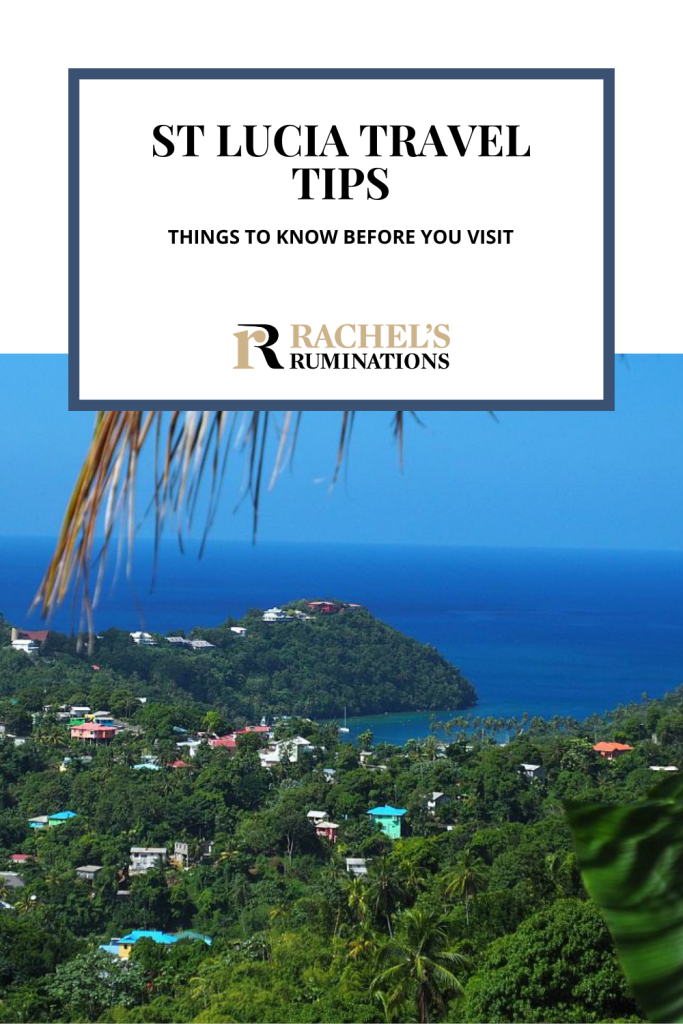
Nevertheless, there were things that I didn’t know ahead of time: things I wished I’d known before I went. Hence, this list of St Lucia travel tips.
What is your idea of a great St Lucia vacation?
What do you want to do on your visit to St Lucia? Are you most interested in spending time at beautiful beaches or beside a pool, tropical drink in hand? Do you expect to travel with your family? Are you interested in activities like hiking or scuba? Do you like to visit historical sites or botanical gardens? Do you want the ease of an all-inclusive resort or do you want more local atmosphere? And, of course, what’s your budget? Your answers will affect your choices in St Lucia.
A beach holiday?
Many of the hotels and resorts on Saint Lucia cater to package tourists interested in spending a week on a beach. Some are big chains like Sandals and Windjammer, but some are locally-owned and one-of-a-kind. Most are along the west coast of the island. Some are along the southwestern coast near the Pitons – the distinct volcanic spires called Petit Piton and Gros Piton. Many more are further north, nearer to Castries, the capital of St Lucia. Some resorts and hotels are all-inclusive, while some have all meals or half-board as optional extras. Any of the resorts would be perfect for honeymoons or destination weddings.
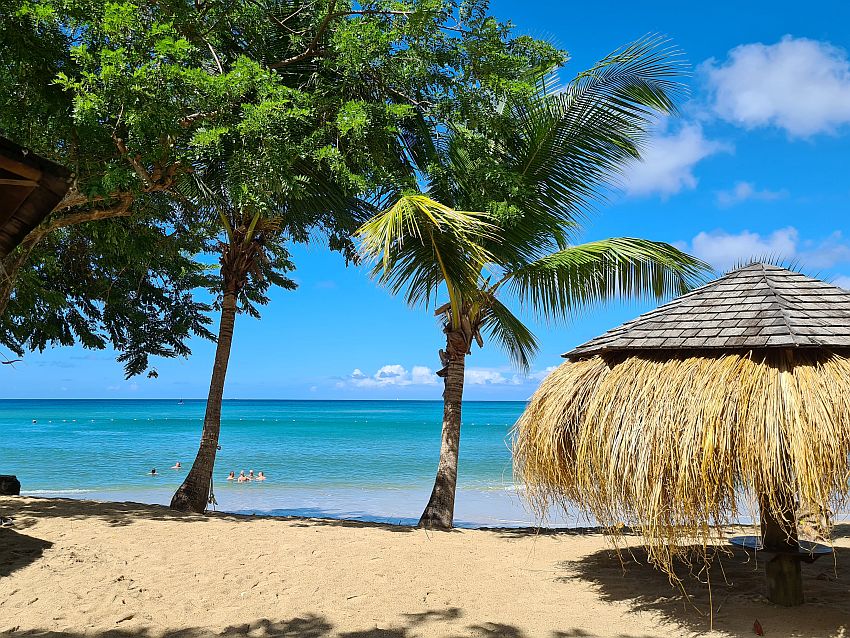
Active sightseeing?
If you want to do the occasional extra activity like snorkeling or visiting a botanical garden, chances are you can arrange an excursion through your resort. Alternatively, book an independent tour or activity, which might end up being less expensive.
However, if your idea of a great vacation is to spend your days going from place to place, seeing everything, like I like to do, you should think carefully about where you stay.
The main sights in St Lucia are along the west coast, and cluster around the town of Soufriere; I wrote a separate article about the things to see there, inside or near the Pitons Management Area, a UNESCO World Heritage site which includes the Pitons and the Tet Paul Nature Trail. These are among the best things to see in St Lucia, especially for nature lovers, but there are other things to see all over the island. Look at the embedded map below, where I’ve marked all of the sights that interested me, and you’ll see what I mean.
When is the best time of year to visit St Lucia?
The temperature in St Lucia is very consistent all year, with high temperatures varying only between about 29C and 31C (84F-88F) and lows between 23C and 26C (73F-79F). The rainy season is June to November, and hurricane season is normally August to October. The best time to visit is between December and May, when you’ll have the slightly milder temperatures and less rainfall. Usually, in that period, if it rains it’s unlikely to last very long.
So where should you stay on St Lucia?
If you want a resort vacation and will mostly stay at the beach or pool, then it doesn’t really matter where the resort is located. Just choose the one you like. We stayed at two in this category. Both were sponsored stays, but I’d recommend them both for very different reasons:
East Winds
East Winds is a small all-inclusive resort just north of Castries. I absolutely loved everything about it. Seriously, you won’t want to leave. They offer plenty of excursions, though, so you can see the highlights of the island without having to rent a car. Read my review here.

Harbor Club
Harbor Club, Curio Collection by Hilton is quite different from East Winds. It’s a hotel more than a resort, and has an all-inclusive option, but we chose to only include breakfast, since we expected to be out and about during the days. Harbor Club is not on a beach; it’s next to a marina. That means no sea swimming, but it has a very pretty pool complex, complete with swim-up bar, jacuzzi, waterfall, shallow-water lounge chairs and all.
Their ground-floor restaurant, Julia’s, is a good place to taste local dishes like green fig and saltfish or curry goat. They also have an Asian-Caribbean fusion restaurant on the top floor which I didn’t get to try, but it has an amazing view. (Speaking of views, if you stay at Harbor Club, choose the middle elevator to see the view!)
As for excursions, a concierge desk can help you arrange them, and sail or boat trips leave from the marina right next door.
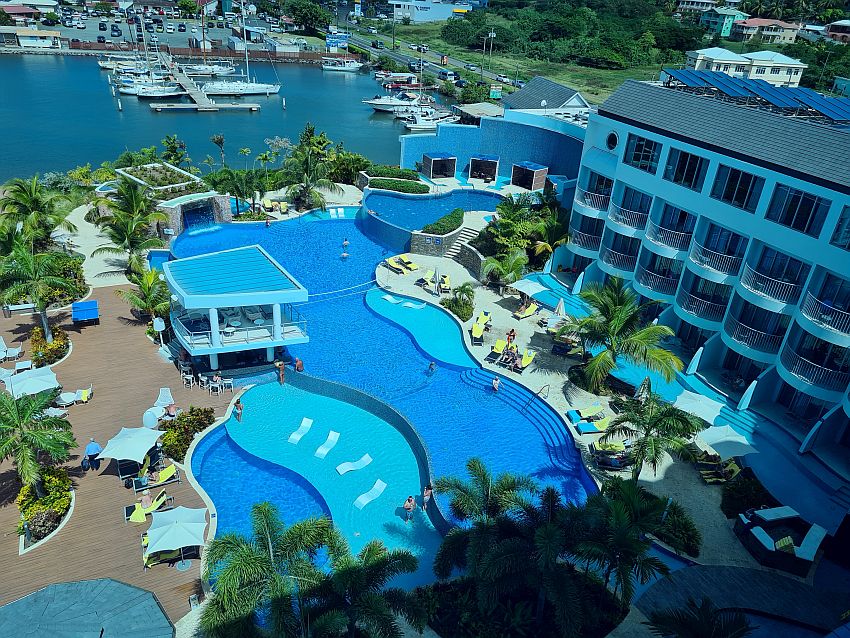
Royal Escape
The third place we stayed was Royal Escape, a self-catering apartment. It’s a big place, with three double bedrooms, two bathrooms, a really big living room and kitchen and also a small pool outside. I like self-catering because it leaves my options open for my meals, and usually it’s cheaper. I’d highly recommend Royal Escape for a large group or family, especially if you don’t really have an agenda. You could hang out in the apartment or by the pool and head to a beach – only a few minutes away by car – when the mood struck. The hosts are remarkably helpful and will answer all your questions.
For us, though, the main problem with Royal Escape was its location. It took us more than an hour, for example, to drive to Soufriere. Since most of the things we wanted to see were nearer to Soufriere than to us, we ended up doing more driving than we would have if we’d booked something closer to Soufriere or just south of it.
Other places to stay
Needless to say, there are plenty of other places to stay, which you can search using the map below. If you want to spend the holiday primarily at a resort, choose any of the ones along the west coast. On the other hand, if you want to rent a car and do lots of sightseeing, choose something in or near Soufriere. Additionally, if you want to get much more off the beaten path, or if you enjoy windsurfing or kitesurfing, book a few nights on the windy east side of the island, which is much less touristed.
Zoom into the map below to see your choices all over the island:
What you should know about beaches in St Lucia
There are plenty of beaches to choose from in St Lucia, from the very popular Reduit beach up north on Rodney Bay to lots of practically deserted ones on the east coast.
All beaches in St Lucia are open to the public. However, many resorts are built around beaches, and this means they can be a) hard to access and/or b) not welcoming. Some resorts seem to have a policy of treating “their” beaches as private in order to deter non-paying guests from using them. If I’d known about this problem, I might have limited my beach time only to beaches without resorts.
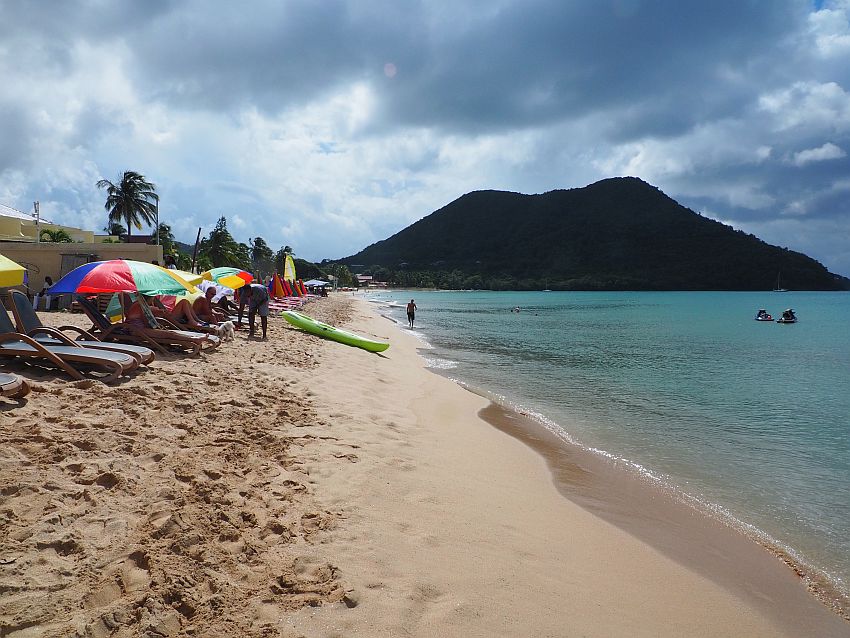
We had two negative experiences trying to reach resort beaches:
Anse Chastenet / Jade Mountain resort
Anse Chastanet is the beach used by a resort called Jade Mountain. It’s right next to a section of the Pitons Management Area where you can snorkel right off the beach.
While the resort looks absolutely gorgeous, the security staff at Anse Chastenet was very unwelcoming, treating us as interlopers, as if the beach was private. I was not allowed to use the bathroom to change into my bathing suit. I do understand that maintaining the bathroom facility costs the resort money, but I wasn’t the only one annoyed by this. A small boatful of tourists from a Sandals resort arrived and almost immediately left after they got a similar reception. I suspect the resort would have amply offset the cost of maintaining the bathrooms by being friendlier: we and the Sandals visitors would likely have spent money at the little bar and café right there on the beach that belonged to the resort.
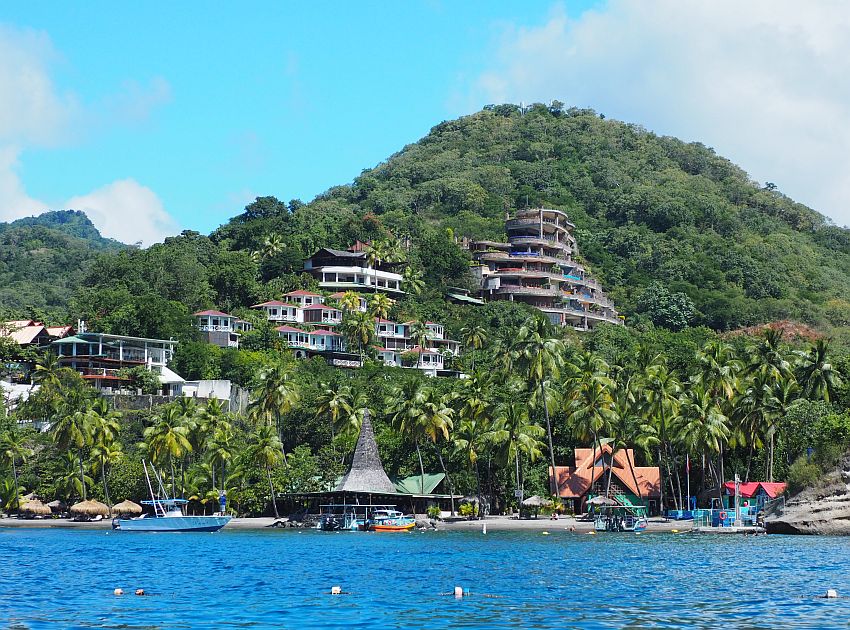
Sugar Beach
Our second negative experience trying to use a resort beach was at Sugar Beach. We chose this one specifically because of its location, nestled between the two Pitons: picturesque volcanic peaks on the water. And again, what glimpses we had of the resort looked wonderful.
As non-guests, though, we were only allowed to park at the entrance, a very long and very steep walk to the beach for two women with bad knees. The reception staff was quite rude to us when we asked for a lift back up on their shuttle bus that goes up and down the hill all day anyway. Eventually, they reluctantly allowed us to. (To be fair, the resort seems to have changed hand, so perhaps it would be better now.)
On the other hand, at the café on the beach we received excellent and friendly service: quite a contrast. It is indeed a lovely beach.
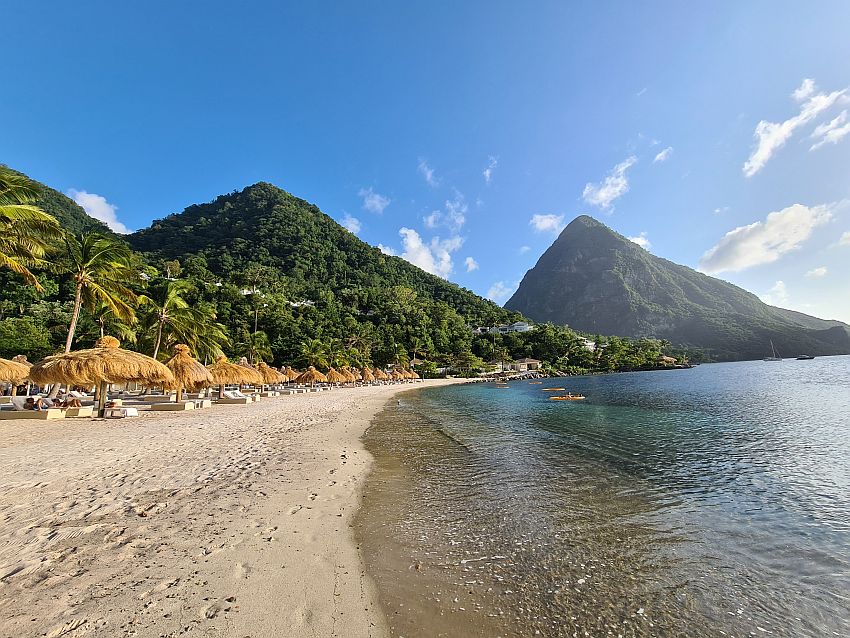
The day after our visit to Sugar Beach, a fellow traveler we’d met at Anse Chastenet decided to go to Sugar Beach too. For some reason, they let him park much further down the hill, close to the beach, so, in other words, your mileage may vary.
Beach recommendations
The point is, plan your beach visits carefully. Go ahead and use resort beaches – it’s your right! – but be prepared for some level of negotiation. Go for the day to get your money’s worth of any lounge chair you rent. Bring food and water if you don’t want to pay resort prices.
Otherwise, choose a beach that the locals use like Reduit Beach in Rodney Bay, Vigie Beach next to George FL Charles Airport, or Pigeon Island Beach. Any village that’s on the shore will have its own public beach as well. Shobha, also a blogger and my travel companion on this trip, wrote up a great list of the best beaches in St Lucia, beautiful white sand beaches that are just as good as resort beaches.
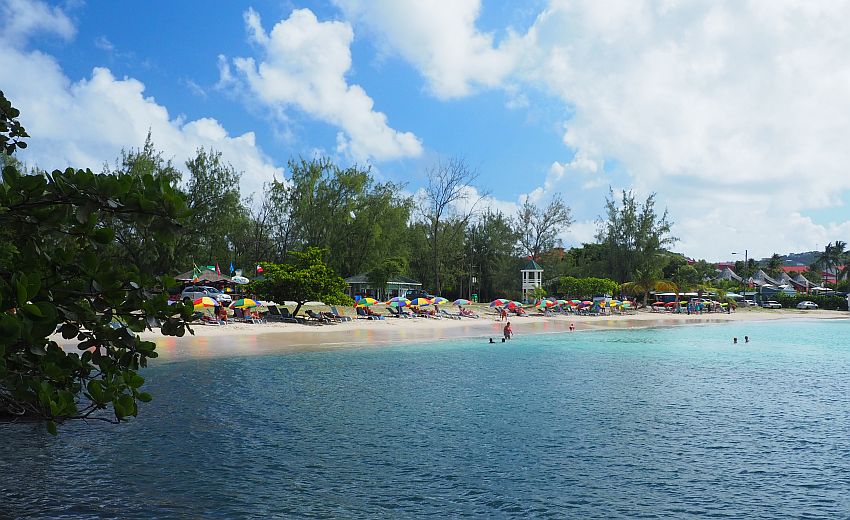
Money in St Lucia
The local currency in St Lucia is the Eastern Caribbean dollar, a shared currency in eight Caribbean nations. EC$2.70 is equal to US$1. Some businesses may accept cash U.S. dollars, but don’t count on it. It’s hard to say how much cash you need because it depends on the type of vacation you’re planning. If you are staying in all-inclusive resorts and are more interested in the beaches than sightseeing, just take out a small amount per day to tip waiters and porters and such. If you’re the more adventurous type, likely to venture out to do some sightseeing, try local food at smaller restaurants or market stalls, or shop at local shops, you’ll need more.
Speaking of tipping, some restaurants add a service charge, so you don’t need to tip. Some don’t, so make sure to check. If you’re staying at a resort, check what their policy is about tipping.
Don’t worry about arranging cash from home – just go to an ATM or currency exchange at the airport on arrival. It’s not hard to find ATMs or banks in towns, or you can usually change money at your hotel reception. Be warned, though, that the exchange rate is likely to be less favorable from a hotel than a bank’s ATM. Your bank at home might also tack on a fee.
You can’t use a credit card or bank card everywhere in St Lucia. Hotels will usually accept credit cards, so if you are eating at hotels, you won’t need cash for your meals. Most shops, though, won’t accept cards, and the same goes for local restaurants and markets.
Before you leave, check with your bank to make sure you can use your bank card abroad and/or your credit card. Outside of the US, Visa and Mastercard are generally more widely accepted than American Express. Using a credit card in an ATM can incur high fees and/or a poor exchange rate. Check before your trip. If an ATM gives you the option of recording the withdrawal in your home currency, say no. Instead, let it record the transaction in Eastern Caribbean dollars. ATMs are notorious for adding exorbitant currency exchange fees. Your local bank will likely do better.
What you need to know about driving on St Lucia
In order to do more active sightseeing like I prefer to do, you’ll need a car. There is public transportation on the island in the form of minibuses. They run frequently – we saw lots of them – but apparently not on a set schedule. Unless you have a very long time to spend on the island, you won’t want to take the time navigating the minibus routes from town to town. Rent a car to pick up right at the airport and keep it with you for the whole trip.
You can use a small car on St Lucia on most roads. If you do, make sure to pay for the full insurance so that damage to the undercarriage won’t cost you. If you can afford it, a bigger, higher car like an SUV would be better.
St Lucians drive on the left side of the road, like in the UK, so your car will have the steering wheel on the right. On the occasional roundabouts, give way to anyone who’s already in the circle: they have the right of way. So look right and wait till no one is coming your way on the circle, then move onto the circle going clockwise.
I wrote a bit about driving on St Lucia in my article about the Pitons. To summarize, the roads are not great. They are paved, but have lots of potholes and generally do not have a paved shoulder. There are no highways in the sense that we know highways in Europe or North America. In fact, many of the main roads are just simple two-lane roads, i.e. one lane in each direction.
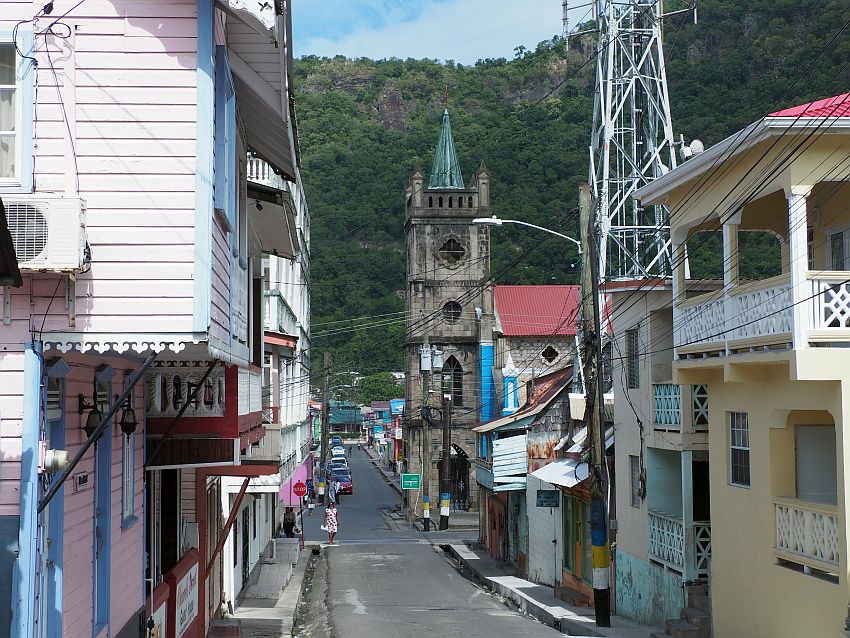
What really causes problems, though, is how twisty the roads are outside the towns – the terrain is mountainous, so the roads wind around and up and down a lot. On the plus side, it means you never have to worry about getting caught speeding – if you have any sense of self-preservation you’ll stay well under the speed limit! On the negative side, if you’re the one driving you really won’t have any opportunity to look at the scenery as you go if you want to avoid crashing.
Saint Lucia may be a small island, but it doesn’t feel that way when you’re driving around on these roads. Whatever your GPS tells you about the time it’ll take you to drive from place to place, count on it taking 20% or more time. Also, be sure to check the map before following your GPS directions blindly. Sometimes we found that it told us a route that looked shorter and faster. Then we’d discover that it was actually very steep and slow through a residential neighborhood, and it would bring us back to the same road we were on to begin with! On the other hand, if you have the time, driving through a residential area gives you a better glimpse of everyday life on the island.
Some other things to know about driving in St Lucia
- Locals tend to drive quite fast, but that’s not surprising given that they know the roads. Just stay to your side of the road – the left! – even when you are going around a curve. Sometimes locals will honk, but this is almost always a courtesy sign. It means “I’m about to pass you, so please stay well to the left to give me room!”
- If you ever need to pull off the road, don’t be impatient. You might need to wait before you find a place with room for your car. If you’ve rented a really small car, be careful not to crunch the bottom as you pull off of or onto the pavement.
- Signage is poor; we spotted very few street signs except in Castries. Few places have street lights either, so be sure you have a good idea of where you’re going before driving at night.
- Parking is generally not a problem. Hotels, resorts and sights generally will have parking if they’re not extremely crowded, though the parking lot might be unpaved.
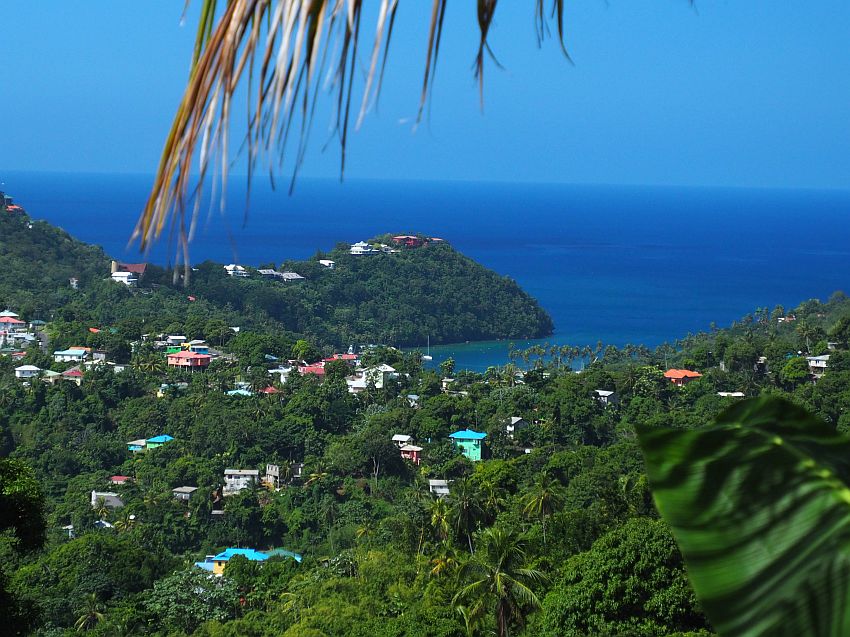
Don’t let any of these warnings scare you off of driving, though! I would certainly do it again if I went there again; I love the freedom of having my own transportation!
Find your rental car for your St Lucia vacation.
Things to know about St Lucia’s history and its effects
Saint Lucia has an interesting history. Like most Caribbean islands, it has a colonial past whose effects are still visible today. Starting in the 17th century, St Lucia kept being passed back and forth between France and England as they fought for control. Each one ruled it seven times, according to Wikipedia, until 1814, when the British took it for the last time. It didn’t become independent until 1979.
Of course, the reason France and Britain kept battling over this place had to do with its value as a colony, particularly as a sugar producer based on slave labor imported from Africa and to a lesser extent from India. Slavery ended on the island in 1838. The sugar industry has mostly disappeared, replaced by bananas and, more importantly, tourism.
What language do they speak in St Lucia?
The official language in St Lucia is English, but most St Lucians also speak French Creole. The place names are often French, but not pronounced quite as the French would pronounce them.
Despite the island’s French colonial history and their local language’s roots in French, their tourism industry seems to focus primarily on UK visitors and, to a lesser extent, Americans, presumably because the British were the most recent colonial rulers. Flights to their international airport are almost exclusively from various cities in the US or from London. They also receive flights from other Caribbean islands nearby. You’ll notice British vocabulary, such as “lift” instead of “elevator.” And the electrical sockets in St Lucia are the British 3-pronged type, and use 240 volts.
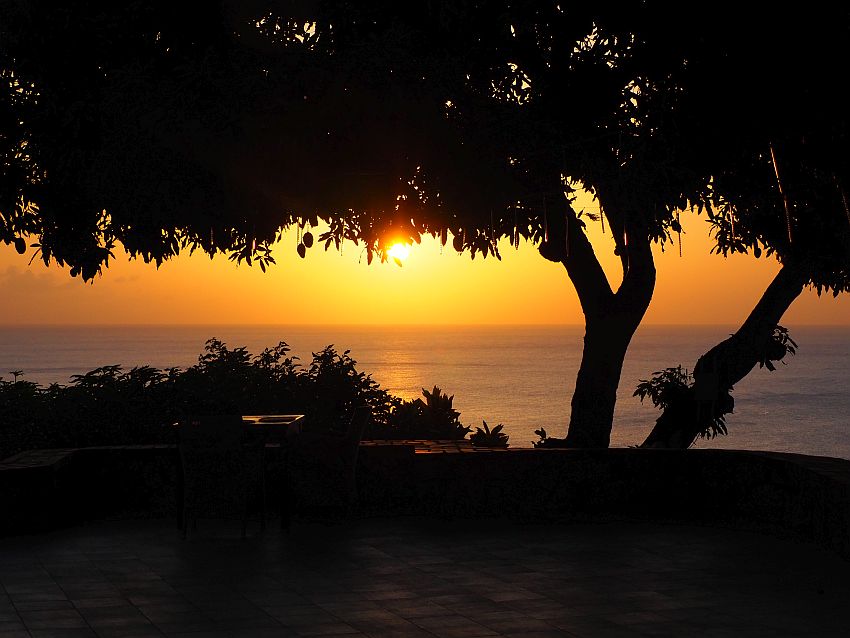
A few other random things to know: more St Lucia travel tips
- Check locally about whether sights, restaurants, etc. are still there. I say “locally” because many blogs and such that we checked ahead of time were out of date. Many businesses have closed, for example, because of the lack of tourist money over the course of the pandemic. Also check locally for up-to-date information about sights. We didn’t discover until we arrived, for example, that the La Sikwi Sugar Mill was no longer a picturesque and tourable historical site: it’s burned down.
- Many businesses and most tourist destinations close on Sundays. Check hours, but don’t expect to do much sightseeing on a Sunday.
- If you are a US citizen and you’re arriving via a closed-loop cruise, St. Lucia doesn’t even require a passport – though you should check official sources to make sure this is still up to date.
If you travel to Saint Lucia after reading this article, I’d love if you’d come back and add your own St Lucia travel tips and observations. Is there anything else you wish you’d known before your St. Lucia trip?
My travel recommendations
Planning travel
- Skyscanner is where I always start my flight searches.
- Booking.com is the company I use most for finding accommodations. If you prefer, Expedia offers more or less the same.
- Discover Cars offers an easy way to compare prices from all of the major car-rental companies in one place.
- Use Viator or GetYourGuide to find walking tours, day tours, airport pickups, city cards, tickets and whatever else you need at your destination.
- Bookmundi is great when you’re looking for a longer tour of a few days to a few weeks, private or with a group, pretty much anywhere in the world. Lots of different tour companies list their tours here, so you can comparison shop.
- GetTransfer is the place to book your airport-to-hotel transfers (and vice-versa). It’s so reassuring to have this all set up and paid for ahead of time, rather than having to make decisions after a long, tiring flight!
- Buy a GoCity Pass when you’re planning to do a lot of sightseeing on a city trip. It can save you a lot on admissions to museums and other attractions in big cities like New York and Amsterdam.
Other travel-related items
- It’s really awkward to have to rely on WIFI when you travel overseas. I’ve tried several e-sim cards, and GigSky’s e-sim was the one that was easiest to activate and use. You buy it through their app and activate it when you need it. Use the code RACHEL10 to get a 10% discount!
- Another option I just recently tried for the first time is a portable wifi modem by WifiCandy. It supports up to 8 devices and you just carry it along in your pocket or bag! If you’re traveling with a family or group, it might end up cheaper to use than an e-sim. Use the code RACHELSRUMINATIONS for a 10% discount.
- I’m a fan of SCOTTeVEST’s jackets and vests because when I wear one, I don’t have to carry a handbag. I feel like all my stuff is safer when I travel because it’s in inside pockets close to my body.
- I use ExpressVPN on my phone and laptop when I travel. It keeps me safe from hackers when I use public or hotel wifi.


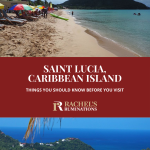
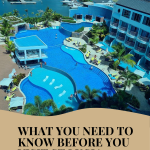
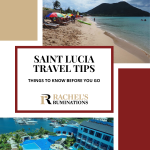

This is a fantastic roundup of essential travel tips for St Lucia! From navigating the local roads to understanding cultural norms, your advice will definitely help make any trip smoother and more enjoyable. I especially appreciate the tips on safety and transportation—it’s always helpful to know what to expect. Your recommendations for local activities and places to stay are also great. Thanks for sharing these valuable insights; they’ll definitely come in handy for my trip planning! ✈️